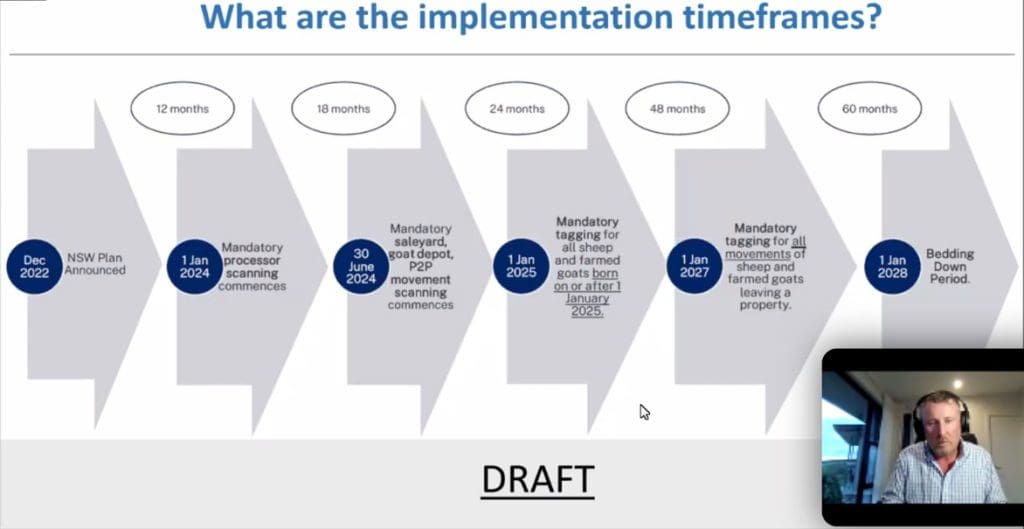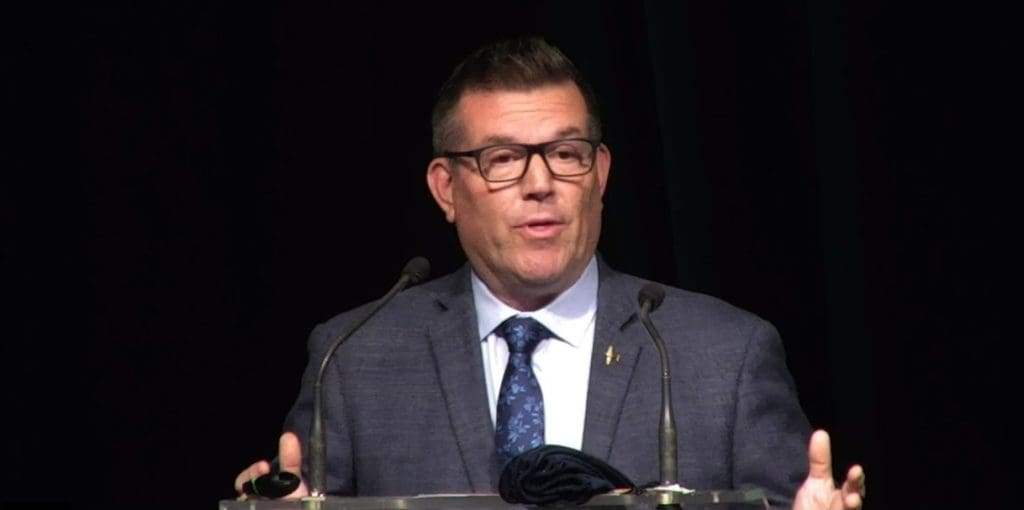
NSW DPI’s Dougal Gordon presented the current draft NSW sheep EID timeframe at a webinar this week.
ALL sheep and farmed goats in New South Wales would be required to have electronic tags for off property movement by 1 January 2027 under a proposed mandatory EID system timeframe.
A draft timeframe shown to New South Wales producers in a webinar this week proposed the statewide mandatory tagging of all sheep and farmed goats born on or after 1 January 2025 in the state.
The proposed timeframe included announcement of a NSW implementation plan in December this year, the start of mandatory processor scanning by 1 January 2024, and mandatory saleyard, goat depot and property-to-property movement scanning from 30 June 2024.
The timeframe draft was released by New South Wales Department of Primary Industries group director livestock systems Dougal Gordon in a webinar on Wednesday. He said the draft had been put before a NSW Sheep and Goat Traceability Reference Group government-industry reference group for further feedback.
“This is where we currently sit, it will likely change, but this is the current timeframes which we are working to.”
Mr Gordon said NSW’s December implementation plan statement would be in line with an AGMIN announcement at that time.
“We are looking at from a producer perspective, mandatory tagging of sheep and farmed goats (born on or after 1 January 2025) and it’s important to point out that we are not talking about harvested goats, but farmed goats.”
He reiterated that the 1 January 20225 date referred only to sheep and farmed goats born on or after 1 January 2025.
“We’ve got a date of 1st of January 2028 for bedding down and what does bedding down mean?
“It means that we can look to try to resolve all those potential teething issues and monitor the current arrangements that we’ve got in place.”
National implementation timeframe is a next step

NSW DPI group director livestock systems Dougal Gordon during the webinar.
Mr Gordon said the next steps were the completion of a national implementation plan timeframe by the national Sheep and Goat Traceability Taskforce.
“There is also a co-design process as well which NSW Farmers has representatives (on) along with NSW DPI, and so we are very much working hand-in-glove in terms of implementation at a national and state level.”
He said NSW DPI is also looking to roll out a series of stakeholder engagement sessions to get feedback and there would be fortnightly reference group meetings through to Christmas. There would also be a study tour of the Victorian saleyards and processors.
“And as the minister (Saunders) highlighted right from the outset, this is very much a joint industry-government process; we shouldn’t at any stage want anyone to believe that this is a fait d’accompli or that government is imposing anything in regard to this matter.”
Is the NSW timeframe too ambitious?

NSW Minister for Agriculture Dugald Saunders first puts his case for national sheep EID traceability to the NSW Farmers conference this year.
After a question from NSW Farmers chief executive officer Peter Arkle on whether the proposed NSW timeframe was “fairly ambitious”, NSW Minister for Agriculture Dugald Saunders said the 1st of January 1 2025 “isn’t the end date, it’s the start date”, of providing a five-year timeframe from early 2023 to get to 2028.
“That somewhere in that timeframe you need to have newborns on property of birth being tagged.
“So that was the midway point basically between 2023 and 2028 – 2025 is definitely a reachable target was the messaging that came back and I think it does set in motion that there does need to be movement,” he said.
“So if you let things wander aimlessly for a period of time then there’s never any surety around this.
So between 2023 and 2028 there is the five-year timeframe that people have talked about, but along that way you need to have other timelines and set it out,” Mr Saunders said.
“This is a draft, if you don’t set some of those draft guidelines, then time does just evaporate.”
He said the 1 January 2025 date was a date to work toward, “where all lambs born on a property would need to be tagged, that’s a starting point for something.
“If we don’t have a starting point to aim at then this will be like herding cats for the rest of our life.”
Mr Saunders said the timeframe was “fed in” by industry and he didn’t think there had been any huge concerns around it at the reference group level.
“It’s been a timeline I think most people have been happy to work towards.”
Timeframe needs clarity around cost-sharing arrangements
Mr Gordon said there needs to be some clarity around potential government assistance, state and federal, because it would have a bearing on the ability to deliver within the timeframe.
“It is an ongoing discussion until we get some of that clarity, but I think it certainly is achievable, as you say.”
On cost-sharing for a mandatory sheep/goat EID system, Mr Gordon said the taskforce had prepared early drafts of a cost-benefit analysis. He added that the costs would be significant for different supply chain participants.
“For example, saleyards, they are going to have to wear a significant portion of the costs.
He said the Wagga saleyards, for example, would need 13 or 14 autodrafters as well as panel readers, software, hardware and Wi-Fi technology. The yards also would need to modify pens and races.
“They are looking $50,000-$60,000 per autodrafter, plus panel readers.
“Processors would also need to put in panel readers.”
Mr Gordon said the reference group had asked all sheep and goat supply chain stakeholders to present to the next taskforce by next Tuesday their potential costs and the government assistance required to aid implementation.
Mr Saunders said people wanted to know that there is going to be some support for the implementation.
“I can’t say exactly what it’s going to look like yet, but that’s the point of the reference group; to really thrash out some of those concerns and see who bears what cost and how, federal level, state level, industry level, producer level, because it isn’t going to be one group that’s bearing all the costs.
“It does have to be a shared cost in some way, shape or form, including from the (state) government, I absolutely fully acknowledge that and the Federal Government does as well and all of the other states.
“So it is a shared cost that we are going to have to look at and the reference group again I think will come to some pretty clear guidelines or thoughts around how we need to get to that cost-sharing arrangement and then that’s when we start looking at how we actually make it happen.”
Mr Arkle said the theme of equitable cost sharing across the value chain is coming through strongly from members.
On the future governance of the implementation plan, Mr Saunders said that will be guided by a similar group made of representatives in the current NSW reference group.
Must ensure no-one gets left behind – Martin

NSW Farmers president Xavier Martin.
NSW Farmers president Xavier Martin said the NSW Government has announced it would support a national sheep-goat EID system during the recent annual conference, in response to the heightened risk of Foot and Mouth Disease. He said conference delegates had provided in-principle support for development of a national individual traceability system for sheep provided it met nine conditions.
These conditions included that the system must have jurisdictional harmonisation, reduce tag costs to an economically affordable level through a national tender, must financially assist farmers and the supply chain to invest in technology, be underpinned by an equitable funding arrangement across the supply chain, ensure the NLIS database has proven capability, retain the option of tag-free pathways, a staged roll-out over a five year period, be developed in consultation with producers and that NLIS be the only system available for stock movements.
Mr Martin said NSW Farmers wanted to understand all farmers’ concerns.
“We have a seat at the state level, the need of farmers are different throughout the state, but we must ensure no-one gets left behind, to paraphrase a current Prime Minister.
“We acknowledge that this is especially critical for our Western Division and harvested rangeland goat farmers, we’re in the business in our association of getting the solution right, not half a solution,” he said.
“It think it’s important to note that electronic tags are just one part of this national traceability reform and I suspect that getting every state and territory to agree to one set of rules will be like herding rangeland goats.”
Mr Saunders said the NSW Government had given NSW DPI $3.5 million for preparation and planning, including an EID implementation project team due to be set up by the end of next month. The state government would also soon be appointing a director within DPI to oversee the implementation.
He said the NSW DPI reference group had met a couple of times and had representatives from NSW Farmers, the Australian Livestock Markets Association, the Australian Livestock and Property Agents Association, the Livestock Bulk and Rural Carriers Association, the Australian Meat Industry Council, Integrity Systems, NSW Police’s rural crime prevention team and sheep industry representatives.

HAVE YOUR SAY